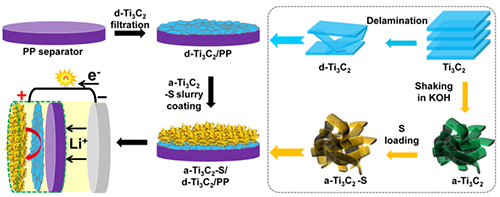Recently, Prof. WU Zhongshuai’s and Prof. CHEN Jian’s groups at Dalian Institute of Chemical Physics (DICP) of the Chinese Academy of Sciences (CAS) collaborated with Prof. WANG Xiaohui from Institute of Metal Research of CAS developed an all-MXene based integrated electrode for high-energy-density lithium-sulfur (Li-S) batteries. Their findings were published online in ACS Nano.

All-MXene-based integrated electrode constructed by Ti3C2 nanoribbon framework host and nanosheet interlayer for Li–S Batteries. (Image by DONG Yanfeng and ZHAO Xuejun)
MXenes are a fascinating large family of 2D transition metal carbides/carbonitrides. And the most common MXene is Ti3C2 MXene with accordion-like layered structures.
However, several structural features of Ti3C2 MXene greatly prevent its application for high performance Li-S batteries, such as big particle sizes, and limited pore volume and surface area.
To overcome the above obstacles, researchers employed 3D alkalized Ti3C2 MXene nanoribbon (a-Ti3C2) frameworks as S/polysulfides host and 2D delaminated Ti3C2 MXene (d-Ti3C2) nanosheets as interlayer on polypropylene (PP) separator, respectively, resulting in an all-MXene based integrated cathode without metal current collector.
The a-Ti3C2 showed rich open macropores and large surface area, which could facilitate a high S loading and easy ionic diffusion. And the 2D d-Ti3C2 nanosheet-based interlayer could further physically and chemically hinder the shuttle effect of polysulfides.
Therefore, the integrated electrode exhibited an excellent electrochemical performance due to the synergistic combination of two different MXene nanostructures in the integrated electrode.
Since MXene could be synthesized from more than 60 kinds of MAX phases, this proposed strategy of constructing all-MXene-based electrode can be readily extended to assemble a large number of MXene based materials for various batteries and supercapacitors.
This work was supported by the National Natural Science Foundation of China, Ministry of Science and Technology of China, and DICP and China Postdoctoral Science Foundation. (Text by DONG Yanfeng and ZHAO Xuejun)